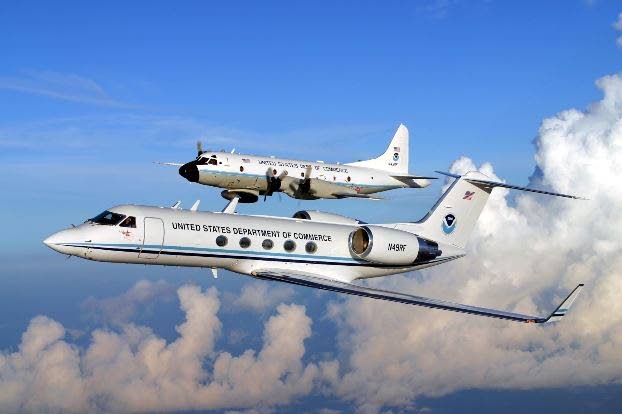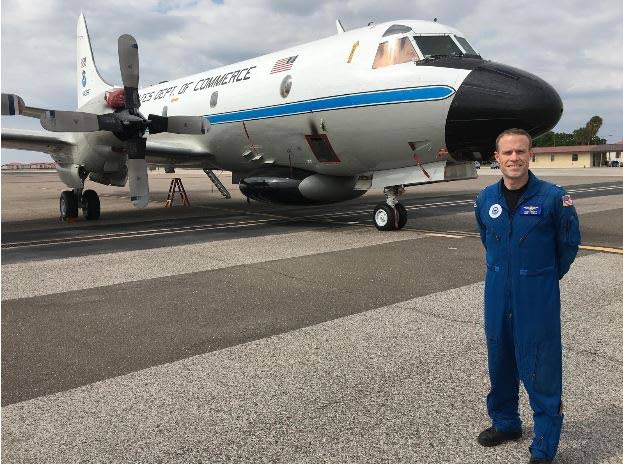Flying into the eye of the storm

The recent passage of Hurricane Beryl through the Windward Islands, including Tobago, underscores the critical role of hurricane hunter aircraft in providing real-time accurate data relating to the characteristics of hurricanes to facilitate the timely implementation of hurricane preparedness plans.
The National Oceanic and Atmospheric Administration (NOAA) is the US scientific and regulatory agency responsible for forecasting weather, monitoring oceanic and atmospheric conditions, charting the seas, conducting deep-sea exploration, managing fishing and protection of marine mammals and endangered species in the US exclusive economic zone. The agency is part of the US Department of Commerce and is headquartered in Silver Spring, Maryland.
The NOAA has a group of hurricane hunters aircraft used for hurricane reconnaissance. They fly through hurricanes to gather real-time operational and research data for analysis by forecasters and scientists. The hurricane hunter aircraft belong to the Aircraft Operations Centre (AOC), based at Lakeland Linder International Airport in Lakeland, Florida.
The AOC has a complement of commissioned personnel from the NOAA Commissioned Corps, federal employees and contractors under the Office of Marine and Aviation Operations (OMAO), which is a line office of the NOAA.
NOAA uses two Lockheed WP-3D Orion turboprops aircraft to fly through hurricanes and a Gulfstream IV-SP which flies around the upper fringes of storms to collect data on steering currents.
With permission from Jim Henson Productions, NOAA's Lockheed WP-3D Orion turboprops aircraft are nicknamed Kermit the Frog and Miss Piggy. The Gulfstream IV-SP is nicknamed Gonzo.
During the Atlantic hurricane season, the WP-3D Orion aircraft are deployed for duty as hurricane hunters. The WP-3D Orion aircraft was designed to tolerate large amounts of turbulence, since it flies through the eyes of hurricanes. The WP-3D Orion aircraft functions as a flying research lab and incorporates numerous features for collecting, analysing and transmitting weather data.
The aircraft also support research on other topics, such as Arctic ice coverage, air chemistry studies and ocean water temperature and current analysis.
Staffed with 18-20 crew members a normal hurricane reconnaissance mission can last from nine-ten hours, while a surveillance mission will typically last eight hours. This is often done in rotation with WC-130 flights from the US Air Force Reserve Command's 53rd Weather Reconnaissance Squadron at six-hour intervals.

Personnel on board include pilots, navigators, engineers, technicians and flight meteorologists.
Most often, the scientists and crew aboard the aircraft deploy GPS-equipped dropsondes, weather devices designed to be dropped out of aircraft at specified altitudes and drop to the earth due to the force of gravity.
During the descent the dropsonde collects data from the surrounding atmosphere which is relayed to the aircraft by radio transmission. Once this data is received and checked by the crew, it is sent to the NHC and the US National Centers for Environmental Prediction (NCEP) for analysis.
Past projects using the WP-3D Orion aircraft included low-level jet observation over South America, a bow echo and mesoscale convective study in the Midwest, and ocean wind satellite verification missions over the Northern Atlantic and Pacific.
The Gulfstream IV-SP is a high-altitude jet that can fly up to 45,000 feet. The G-IV crew is similar to the WP-3D Orion and includes NOAA Corps aviators, engineers, technicians and a flight meteorologists.
The Gulfstream IV-SP flies around the periphery of both tropical and winter storms, including hurricanes, and uses dropsondes in order to gather data about the surrounding environment. This information is used to help predict the path and intensity of hurricanes.
The Gulfstream IV-SP also serves the NCEP Winter Storm Reconnaissance programme to better predict the location and intensity of winter storms that affect the US. During winter-storm reconnaissance, air-chemistry measurements are also taken from the upper troposphere. These flights are typically flown from Honolulu, Anchorage or Yokota AB, Japan.
The training of a commercial pilot and a hurricane hunter diverge sharply.
The commercial pilot is trained to avoid bad weather; the NOAA hurricane hunter pilot is trained to fly specially equipped aircraft directly into the eye of the storm to collect crucial data. Hurricane hunter pilots are trained to fly through the worst storms on earth, over and over.
The flight crew of a hurricane hunter is normally given 48 hours of notice for a flight. It takes a significant amount of preparation to deploy a full crew to a variety of international locations. Crew work and sleep schedules are adjusted to ensure each member is adequately rested for the launch.
On the day of the flight, a normal preflight check starts two-three hours before takeoff. The pilots – flight director and navigator – hold a mission brief with science team personnel to review the planned route, mission profile, data collection objectives, current and forecast storm development, expected hazards (convection, icing, salt accretion), weather for takeoff and landing and the en-route portion.
Successful hurricane missions are outstanding examples of teamwork.
Crew members are by no means fearless.
Commander Scott Price, a NOAA commissioned corps officer, spoke about the healthy anxiety he feels before a storm flight.

"No matter how often we fly into these systems, the natural inclination of the pilot in me to avoid inclement weather will never go away entirely, and ultimately helps foster my immense respect for every storm we approach.
"Watching the target cyclone churn on the radar loop during the mission brief usually sparks that anxiety and also helps ground my mental preparation for the flight ahead. And though we go into each storm armed with the best available information about the conditions we should encounter, the dynamic nature of the environment means the only sure things about your trip through are the bumps behind you," he said.
This year is forecast to have a very active hurricane season, and the hurricane hunters will play a vital role in helping to protect lives and property.
At present they are investigating AL96, a tropical wave with the potential to become a hurricane.

Comments
"Flying into the eye of the storm"